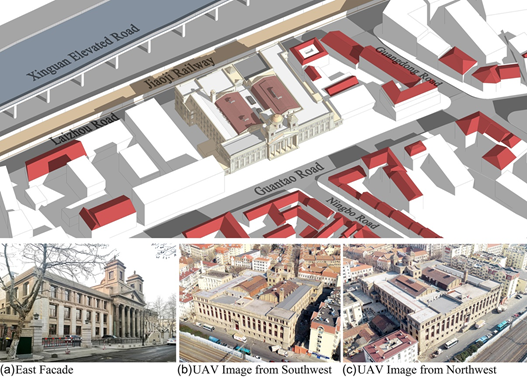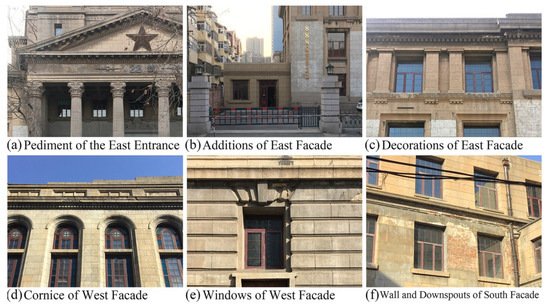The Qingdao Exchange Building, built in the 1920s, is the largest products and stock exchange building in modern Shandong. In addition to being a historical witness to the economic development of Qingdao over the last 100 years, it has also been a historical scene of cultural exchanges between China and the West after the opening up of China in the early 20th century. After several changes in the building’s property rights, the building was out of use for a long period of time, with a large number of materials and structures being damaged.
- Qingdao Exchange Building
- Chinese Modern Architectural Heritage
- value analysis
- rehabilitation strategies
Qingdao Exchange Building
1. Introduction
Qingdao is a new port city in Shandong Province in modern China, with a deep-water port and Jiaoji Railway. From the end of the 19th century to 1949, Qingdao was alternately occupied by Germany, Japan, and the National Government. As the frontier area influenced by Western culture in the Shandong Peninsula, the old urban area of Qingdao retains a large number of Modern Architectural Heritage sites. In January 2019, a special leading group was set up to launch the official application of the old city of Qingdao for the Preparatory List of World Cultural Heritage, which promoted the progress of architectural heritage protection. Built during the Japanese occupation in the 1920s, the Qingdao Exchange Building is the largest products and stock exchange building in modern Shandong (Figure 1).

Figure 1. Qingdao Exchange Building.
2. History
Exchange buildings, which originated in Europe in the late Middle Ages, are organized and standardized trading places for bulk commodities or financial assets. With the functions of facilitating trading, circulating goods, adjusting finance, and leveling market prices, Exchange buildings were derived from financial war and were a significant factor in the development of the national economy and financial industry [1]. From the Meiji Restoration in 1868 to the outbreak of the First World War, Japan’s economy exhibited a trend of rapid growth, transforming an agricultural country into a modern industrial country. Japan introduced the new market organization system of Exchange buildings from Western countries so as to promote the primitive accumulation of capital. In 1914, there were 44 Exchange buildings in Japan, which promoted the development of Japan’s domestic industrial revolution [2].
The early Japanese Exchange buildings emerged in Dalian, Shenyang, Changchun, and other places in northeast China as Japan gained privilege in northeast China after the Russo-Japanese War in 1905. Between 1920 and 1921, as a result of the domestic economic crisis, Japan intensified the control of raw materials, products, and capital markets in colonial and semi-colonial areas. From 1916 to 1921, Japan set up over 100 enterprises in China, including various Exchange buildings founded by Japanese officials and private capital [3]. In 1919, Japan set up a government-run Exchange building on the Dexian Road of Qingdao. In 1920, the building was forced to set up a Sino-Japanese commercial joint exchange. The initial trading market was located on Dabao Island, including four trading departments: securities, gauze, local products, and currency. In 1921, there was a plan to build a new building on Guantao Road, but the plan was shut down soon after due to a lack of funds. Later, the Japanese military financed the project from opium sales, ensuring the progress of construction [4]. In August 1926, the building was completed with a total building area of 18,276 m2. In September of the same year, Qingdao Exchange was officially opened, and several rooms were rented out to other companies and banks as offices [5]. The building was adjacent to Xiaogang Wharf in the west and Customs and Dagang Railway Station in the north, which was convenient for both ocean and railway transportation. Additionally, Guantao road was connected to Zhongshan Road Commercial Street in the south, surrounded by supporting facilities such as finance, transportation, catering, and tourism.
From its establishment to the early 1930s, the Qingdao Exchange Building basically monopolized the trading market of agricultural products and main goods until Qingdao Commodity Stock Exchange was set up by Chinese merchants with the support of the municipal authorities in 1931. After the outbreak of the Second World War, Japan’s excessive involvement in foreign wars led to an extreme shortage of materials, and circulation was restricted. In 1944, the Qingdao Exchange Building was forced to close [6].
After the end of the Second World War, the Qingdao Exchange Building was occupied by the military of the Nationalist Government and ended its trading function. From November 1945 to June 1949, the Qingdao Exchange Building was used for the army of the Nationalist Government. After the founding of the People’s Republic of China in October 1949, the Qingdao Exchange Building was used for the Chinese People’s Liberation Army. After 2000, the building was gradually left unused. In 2006, the Qingdao Exchange Building, along with other Modern Architectural Heritage sites on Guantao Road, was announced as the third batch of Provincial Cultural Relic Protection Units of Shandong. In 2014, the interior decoration of the building was partially updated and then leased to enterprises, but the utilization rate was low. At present, with the Guantao Road Historical Block emerging as a famous place for cultural tourism and leisure, as well as being a popular public area for visiting, traveling, photography, and leisure activities, the Qingdao Exchange Building is in urgent need of renewal and reuse.
To summarize, the modernization of Qingdao City and the Guantao Road block has occurred over the last 100 years, with the Qingdao Exchange Building being a particular site for historical figures and historical events. In addition to being a historical witness to the commercial and economic development of modern Qingdao, the Qingdao Exchange Building has also been a historical place for cultural exchange between the East and the West since the opening up of China to the Western World in the early 20th century. Exchange buildings, as a building type, reflect the authenticity, importance, and integrity of historical information, which shows important historical and cultural values.
3. Current Status




References
- Pevsner, Nikolaus . A History of Building Types; Princeton University Press: Princeton, NJ, USA, 1976; pp. 209-212.
- Sun, Jianhua. Modern Japanese Exchanges in China (1906–1945); Social Sciences Academic Press: Beijing, China, 2018; pp. 37-41.
- Sun, Yuqin. A History of China’s Foreign Trade; University of International Business and Economics Press: Beijing, China, 2004; pp. 182.
- Ye, Chunchi. The Vicissitude of Qingdao Exchange. In Collection of Industrial and Commercial Economic Historical Materials of Shandong; Shandong Committee of Cultural and Historical Data of the CPPCC, Ed.; Shandong People Press: Jinan, China, 1989; Volume 2, pp. 23–30.
- Digital Archive Resources of Qingdao Chamber of Commerce. Available online: http://www.qdda.gov.cn/qddaxxw/qddaxxw/cdfw/zxgb/qdsshdaxj/index.html (accessed on 12 May 2022).
- Feng, Jian; Liang, Xiaoyi; Futures Trading in Qingdao during the Republic of China. Research of Urban History 2021, 1, 18-36.
